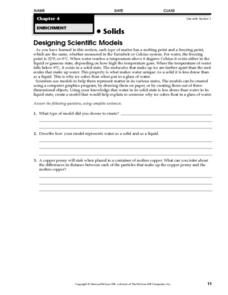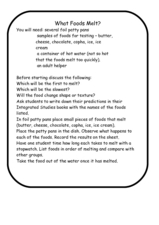Curated OER
Chemistry 115 Practice Exam 3
Radioactive decay, pH, properties of elements, organic compounds, and stoichiometry are all touched upon through this practice chemistry exam. It always helps learners to take a practice test in preparation for the actual exam. This...
Curated OER
Heating and Cooling Materials
When an object is heated or cooled, a change occurs. Learners will work through this presentation and decide whether or not the changes are reversible. They learn about heating and cooling, then assess changes that have taken place. This...
Curated OER
11 - The Heat Is On
Students observe physical change of melting by observing substance in original state, melting substance, allowing substance to return to original temperature, determining if substance retained its original properties, and recording results.
Curated OER
Water and Ice
Students explore water and how it changes forms. For this investigative lesson students participate in an activity that shows them how water changes form and what it looks and feels like.
Curated OER
Physical and Chemical Properties
These slides summarize the properties that define materials. The categories of physical and chemical changes that are used to describe substances are listed and students will find the examples of those changes useful. You could set the...
Curated OER
States of Matter
By viewing this PowerPoint your students' understanding of molecular energy should increase. The properties and inter-particular forces are summarized. The logical progression of information is useful, but more data to demonstrate...
Curated OER
Preparation of Triiodomethane (iodoform)
In this preparation of triiodomethane instructional activity, learners use propanone to prepare triiodomethane. Students use filtration and recrystallization in order to make the product. They determine the melting point...
Curated OER
States of Matter Summary
In this states of matter worksheet, learners are given a summary of the particle arrangement, the motion of particles, the properties of particles and models of particles in solids, liquids, and gases. Melting, evaporating and boiling,...
Curated OER
The Frigid Gourmet
High schoolers make a " science surprise" or ice cream in the lab. In this melting point depression lesson plan, students use various substances with ice to determine the effects on the melting point of ice and the ability to make ice...
Curated OER
Thermochemistry
In this thermochemistry worksheet, students indicate whether the given processes are endothermic or exothermic reactions. Students complete the phase change diagram as well as define a given set of vocabulary words. Students calculate...
Curated OER
Designing Scientific Models
In this scientific models worksheet, students will use a model to represent matter in its various states. Students can use a computer graphics program, drawing on paper, or three-dimensional creation. Then students will complete 3 short...
Curated OER
Intermolecular Forces
In this chemistry worksheet, students identify the types of intermolecular forces for 5 different compounds then rank compounds by increasing melting point for 3 additional questions.
Curated OER
Melting, Freezing, and More!: Phase Transitions
Third graders listen to a talk on phase transitions and view three demonstrations. In this phases of matter lesson, 3rd graders complete a worksheet as they listen about phase transitions. They move through three demonstrations of phase...
Curated OER
Ionic Compounds
For this compounds worksheet, students review the structure and properties of ionic compounds, their formulas and nomenclature, and molecular mass and percentage composition. This worksheet has 4 short answer questions and 7 problems to...
Curated OER
Snowman
Students read books, learn about the letter s, and eat snow all to learn about snowmen. For this snowman lesson plan, students also view ice melting and sing songs.
Curated OER
Kindergarten Tries to Save the Snowman!
Students look at the properties of snow. In this snow lesson, students discuss what they know about snow and what makes snow melt. They come up with ideas to slow the melting process of snow.
Curated OER
Why Do Ice Cubes Melt?
First graders investigate water properties by participating in a hands on experiment. In this ice formation lesson, 1st graders examine real ice cubes in a bowl and identify the reasons why certain cubes melt faster than others. Students...
Curated OER
Solids and Liquids
In this solids and liquids worksheet, students analyze the table of melting points of common materials in order to answer the questions given.
Curated OER
What Foods Melt?
In this science worksheet, students experiment to determine which foods melt using hot water in metal pans. They write predictions about which foods will melt and which will melt the fastest. They perform the experiment and note the what...
Curated OER
Characteristics of Crystals
In this crystals worksheet, students complete a graphic organizer by filling in the characteristics of the different crystal types including melting/boiling point and electrical conductivity.
Curated OER
Comparing Properties of Elements & Compounds
In this elements and compounds worksheet, learners review the physical properties of different compounds and elements using websites for information. This worksheet has 1 graphic organizer and 1 short answer question.
Curated OER
Elements, Compounds, and Mixtures
For this elements, compounds, and mixtures worksheet, students answer questions about the properties of elements, mixtures, and compounds. Students identify the physical changes that is made to a substance to determine if it is an element.
Curated OER
Physical and Chemical Trends in the Group 7 Elements
In this elements worksheet, students complete a graphic organizer by comparing the melting point, boiling point, density, and electronic configuration of given elements. Students determine the characteristics of Group 7 elements. This...
Curated OER
Trends in Physical Properties of Group 2 Elements
In this elements worksheet, students complete 2 graphic organizers by comparing the element symbol and melting point for given elements. Then students plot a graph of their atomic radius against proton number.

























